BEIRUT (Analysis) — There are only two areas in Syria today that are not under government control. Jobar is one of them, and it is situated east of the historic “Old City” section in the capital Damascus. The terrorists — each group of whom is named and described individually below — firmly embedded themselves in Jobar from the early days of the Syrian conflict in 2012 and ever since, it has been a tug of war between U.S.-backed rebels attempting to oust President Bashar al-Assad and the Syrian Arab Army and its allies fighting that foreign-backed terrorism.
The Syrian Arab Army and its allies have fought to gain control of the area for years, slowly inching forward and tightening the noose around a mixed-bag of foreign-backed terrorists.
However, just as East Aleppo was liberated by the Syrian Arab Army (SAA) from U.S.-backed al-Nusra Front (Al-Qaeda’s Syrian branch) in December 2016, one year later the city of Jobar is in the final death throes.
The siege of Jobar

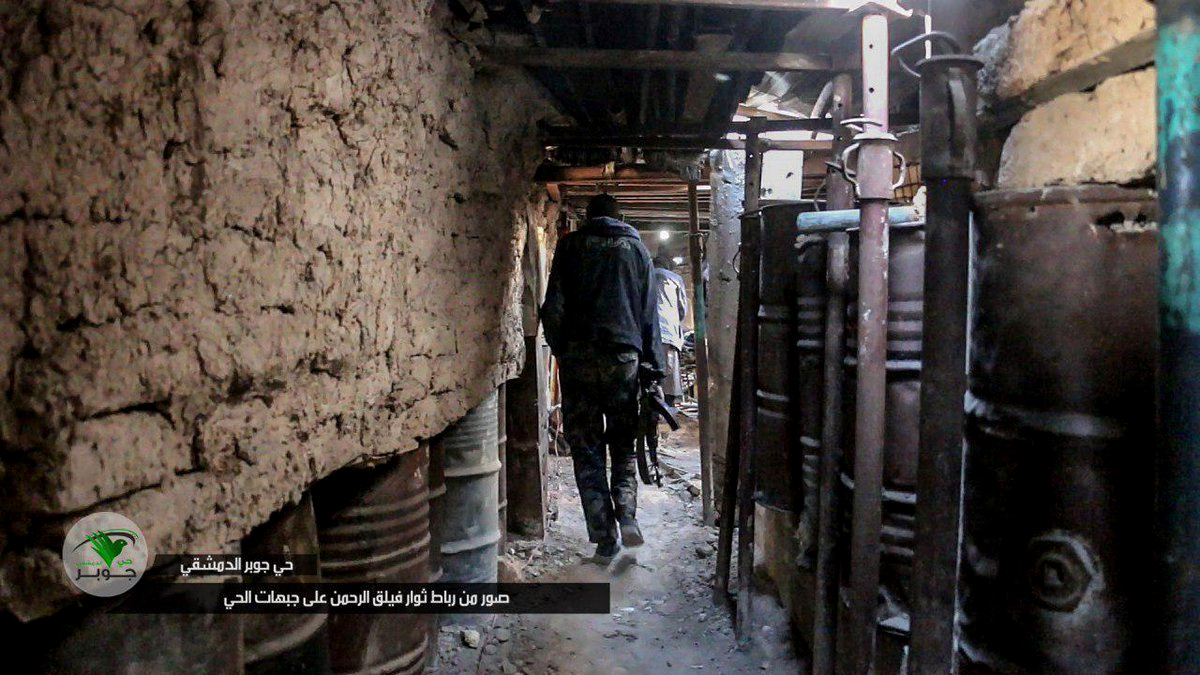
The Free Syrian Army, as well as other rebel factions, used a complex tunnel system under Jobar to resupply, and as a base for attacks against Syrian troops. (Photo: Twitter/@CombatChris1)
Jobar had been just an ordinary neighborhood in the suburbs immediately adjacent to the capital of Damascus.
However, the city developed into a terrorist stronghold in large part thanks to an ancient cave system which runs beneath the city and is easily accessed via the historical buildings that sit above them. The caves below Jobar made the perfect hiding place for terrorists and, equally important, a safe storage area for their weapons and the basic supplies needed to sustain a prolonged battle.
Many journalists have written about the SAA’s siege of Jobar, but the word siege implies a place encircled and cut off from supply routes, thus in a position to eventually garner surrender due to lack of supplies. However, Jobar was never completely under siege. The supplies have been constantly re-stocked, and the supply routes open. The routes are made up of several complex tunnels that permit the safe entry and exit of food, medical supplies, weapons and fighters.
Life in Jobar is made possible by this underground support.
Damascus : Some of Rahman Corps heavily fortified fighting positions in #Jobar. pic.twitter.com/8o4MwbNgC6
— Christian Turner (@CombatChris1) December 5, 2017
In every conflict, there are the people who suffer losses and those who profit from them, and wish the war would never end, and smuggler Muhie al-Din Manfoush will sell to anyone. Most of the international aid from both institutional and private donors end up in Manfoush’s pocket since he is, in many cases, the only source of supplies.
Tunnels take time and manpower to dig. The terrorists began their hold on Jobar in 2012, and the tunnels were being dug from the outset. Terrorists didn’t spend time doing the labor; they used prisoners to dig the tunnels under threat of death. Syrian soldiers, rival terrorist factions, and civilians in the area — men, women and children who had refused to support their ideology — did the digging. The evidence of prisoners held by the terrorists was front-page news worldwide after they had placed men and women in metal cages, reminiscent of a circus, and drove them around the area for display before killing them.
Who supports the ‘opposition’ in Jobar?
President Barack Obama and Secretary of State Hillary Clinton developed a plan to overthrow the Syrian government and that plan was put into action in March of 2011 in Deraa, Syria. From the outset, weapons, cash and supplies were smuggled into Syria by U.S. intelligence agents, the U.S. military apparatus, and U.S. State Department operatives.
The most well-known beneficiary of U.S. support was the Free Syrian Army (FSA), which has had a presence in Jobar from the outset and remains there to this day. The FSA has changed leadership, and morphed several times, but remains reliant on American support — both through the Trump administration and through U.S. Congressional leaders such as Sen. John McCain (R-AZ), who made a visit to ‘his’ troops in Syria on May 27, 2013.

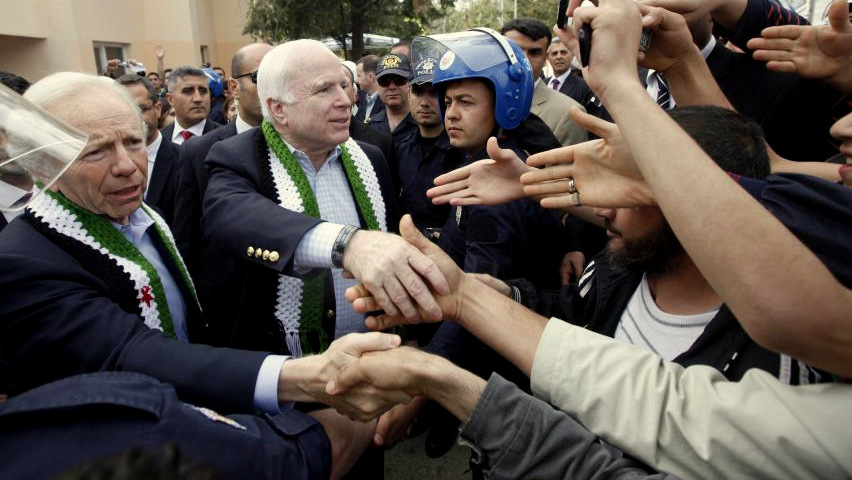
U.S. Senators John McCain (R-AZ) and Joseph Lieberman (D-CT) greet men at a refugee camp during a visit to the Turkish-Syrian border April 10, 2012. (Umit Bektas/Reuters)
Sen. McCain tirelessly lobbied for the FSA in the U.S. Congress, passing legislation to the give the group cash and weapons. As recently as April 2017, McCain was rooting for the “…brave fighters in Syria who are risking their lives for freedom and need our help.”
The so-called Army of Islam

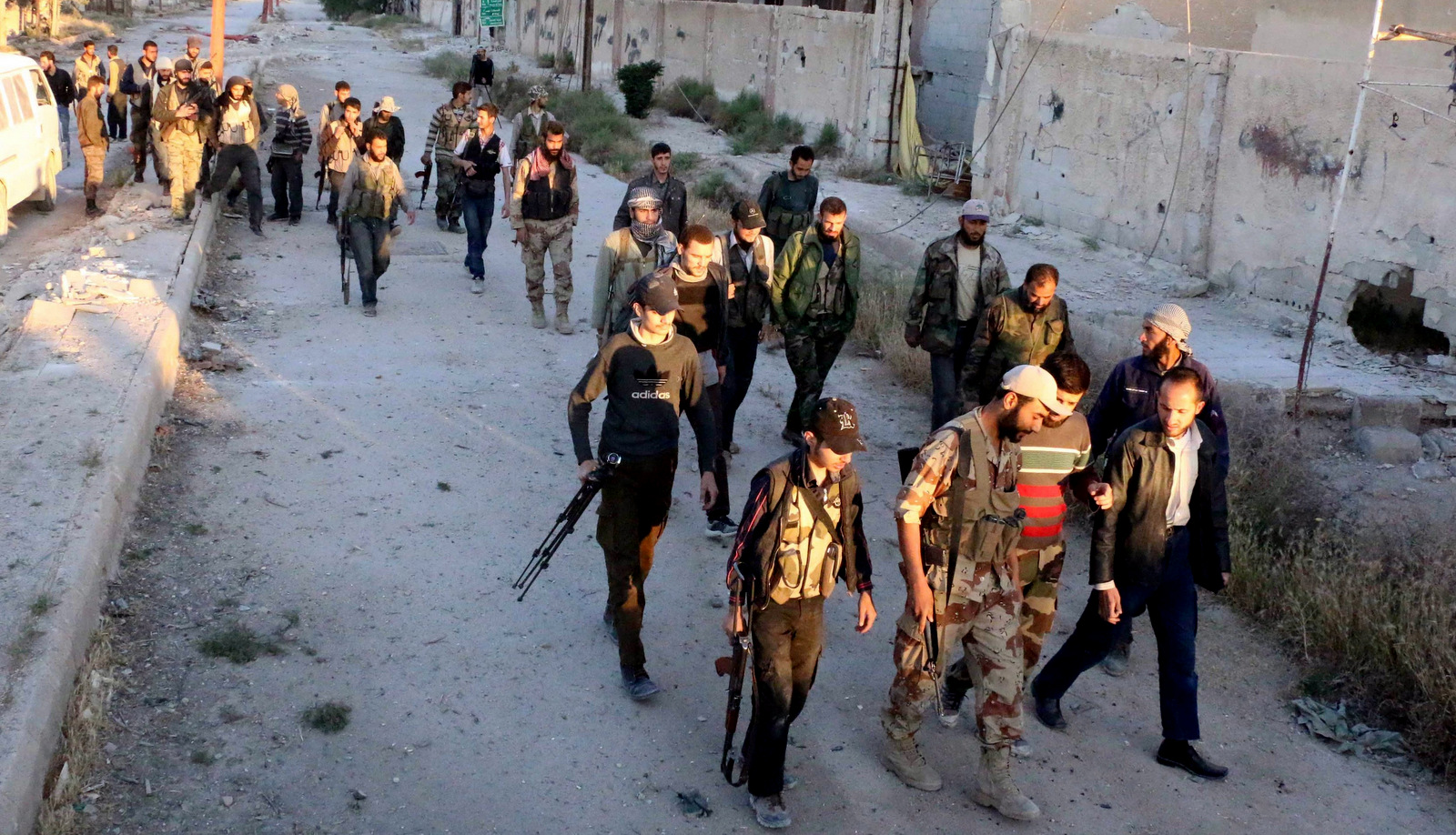
Rebel fighters of Jaish al-Islam (Army of Islam) pictured at an unknown location in Syria on May 6, 2015. (Amer Almohibany/Reuters)
Jaish al-Islam (The Army of Islam), is the foremost terrorist group operating in the Damascus area. Its founding leader, Zahran Alloush, was killed in December of 2015. However, his brother Mohammed Alloush continues to head the political wing of the group and has been a featured representative of the Syrian opposition at the Syria peace talks in Geneva. Saudi Arabia supports Jaish al-Islam with cash, supplies, weapons and satellite imagery, as well as with Saudi military advisors. Zahran Alloush openly denounced democracy and called for an Islamic state to succeed Assad.
Despite the Saudis’ newly founded “War on Terror,” the Saudi King is still supplying Jaish al-Islam.
We know what Jaish al-Islam did to the civilians in East Aleppo:
They (the rebels) did not allow us to eat even a piece of bread.”
As reported in a Euronews article by Alasdair Sandford:
They say they found food and other supplies in a school which Jaish al-Islam used as its headquarters in the district of al-Kalasa. The Saudi-backed group withdrew following the Syrian army’s advance. ‘They forbade us everything. There is no milk, there is no cooking, there is no meat, neither are there any lemons. They forbade us everything,’ said Hanan al Salem, a local woman who went into the abandoned building after the rebels’ departure.”
‘They kept all these items here and there,’ added another resident, Amer Saleem, as he pointed out different parts of the building. ‘They did not allow us to eat even a piece of bread. Some of us went to sleep hungry and others of us died of hunger.’”
Rebranding the FSA: Failaq Al-Rahman

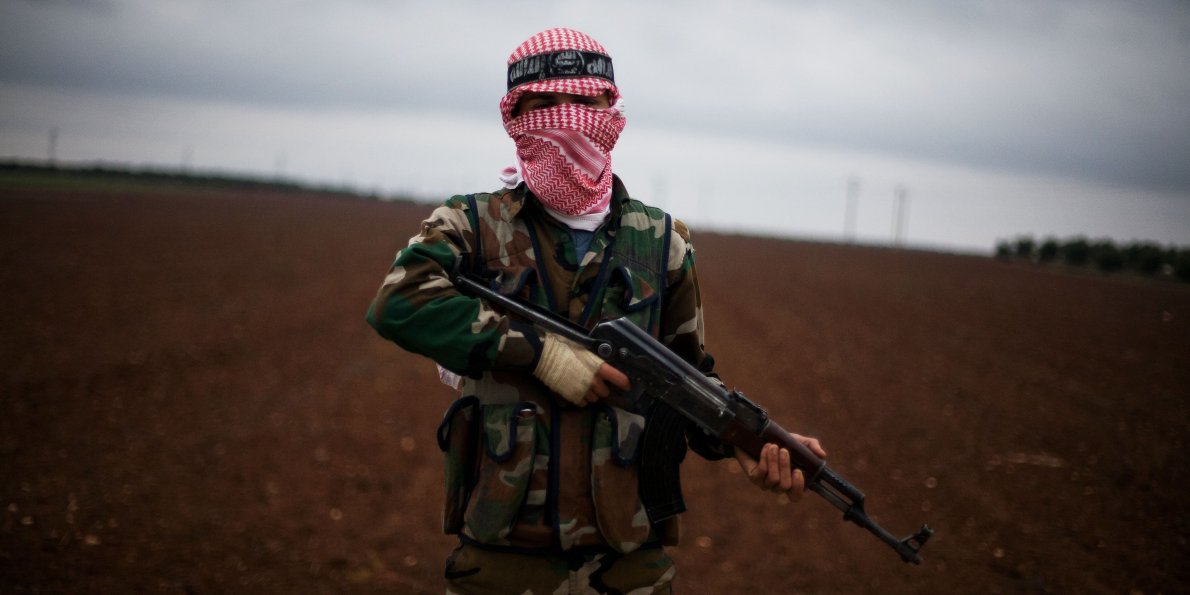
A Free Syrian Army (who now call themselves Failaq Al-Rahman) fighter takes position close to a Syrian military base near Azaz, Syria, Dec. 10, 2012. (AP/Manu Brabo)
Failaq Al-Rahman is the new branding of the original Free Syrian Army (FSA). The group’s leader, Abdul al-Nasr Shamir, is a captain who defected from the Syrian Arab Army in early 2012. The FSA was the brain-child of Obama, and the pet project of Senator McCain. The group enjoyed the full support of the U.S., NATO, and the Gulf Arab states.
However, this ‘rebel’ group was depending on a groundswell of support for their so-called “grassroots” rebellion, but that support never materialized. The Syrian “revolution” was a Western invention and it seems as if the personalities behind it failed to check whether the majority of Syrian citizens living inside Syria in 2011 had the will to support the FSA by bearing arms and fighting a revolution. It wasn’t long before the designers of the war in Washington were back at the drawing table, looking for “Plan B.” With local fighters in short supply, the only alternative was for the FSA to call on their “brothers in arms” from across the globe. The fact that they were jihadists following a radical interpretation of Islam didn’t matter. What mattered most was having “boots on the ground.”
No would-be revolution had a chance of defeating the Syrian Arab Army without first possessing massive numbers of fighters. The Syrian people were not interested in killing their neighbors in order to please the U.S., U.K., or the Arab monarchies. The Syrian people, in the majority, knew that the conflict was not about freedom or democracy, but about stripping Syria of its independence and resources.
Gradually, the FSA dwindled to the point that it barely had a presence on the ground in Syria, but the group lived on in the memory of the Western media with a form of amnesia: recalling long-term memories, but not remembering who was who in the present. Reinventing the FSA as Failaq Al-Rahman was the method chosen for keeping the American-backed faction alive, and the supplies restocked, with the U.S. and Qatar acting as the primary benefactors.
The Rebel Melting Pot

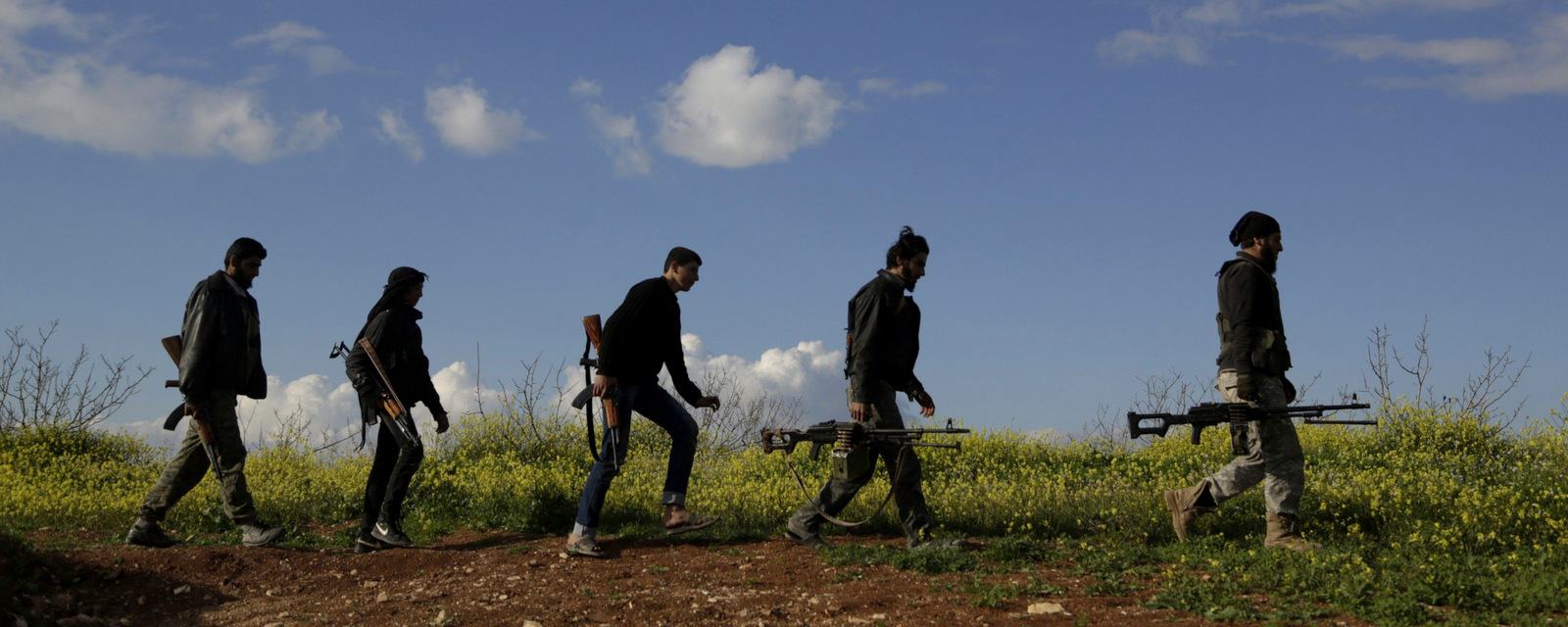
Fighters from the Ahrar al-Sham carry their weapons as they move towards their positions near the Morek frontline in the northern countryside of Hama, Syria, March 16, 2015. (Khalil Ashawi/Reuters)
Hayat Tahir al-Sham (HTS) likes to label itself as a melting pot of all factions. The group, which was essentially al-Qaeda in Syria, went through so many transitions and alliances that a new name and image was needed to rebrand itself.
In a statement announcing the creation of HTS, the group said it had joined forces with the Nour al-Din Zinki Movement, one of the most important opposition factions in Aleppo province. In July of 2016, the U.S. State Department came under heavy criticism because of its support of Nour al-Din Zinki, after the group proudly posted a video of its members beheading a young boy in Aleppo. Despite the atrocity and subsequent outcry, the State Department continued its support for the group.
In June of 2017, the Syrian government forces launched a major military operation in Jobar in a bid to capture the long-standing HTS stronghold. HTS retaliated by shelling Damascus with more than 20 missiles which struck the Syrian capital, killing at least four civilians and injuring 10 others. Last month the Syrian Arab Army destroyed a sniper nest in Damascus used by HTS.
While the U.N. and humanitarian groups decry the siege of Jobar and the possible famine it could produce, Hayat Tahir al-Sham announced through their own media channels that they had slaughtered 100 lambs to celebrate the death of SAA Maj. Gen. Issam Zahreddine, who died in Dier Ez Zor fighting ISIS in October, 2017.
With this announcement, the group was sending a message to the world that they are well fed, and have access to fresh meat. While the struggling families in Damascus, who have seen the value of their income decrease due to U.S. and E.U. sanctions, can only dream of being able to eat fresh lamb while the terrorists tormenting them in their shops, schools and homes are eating well.

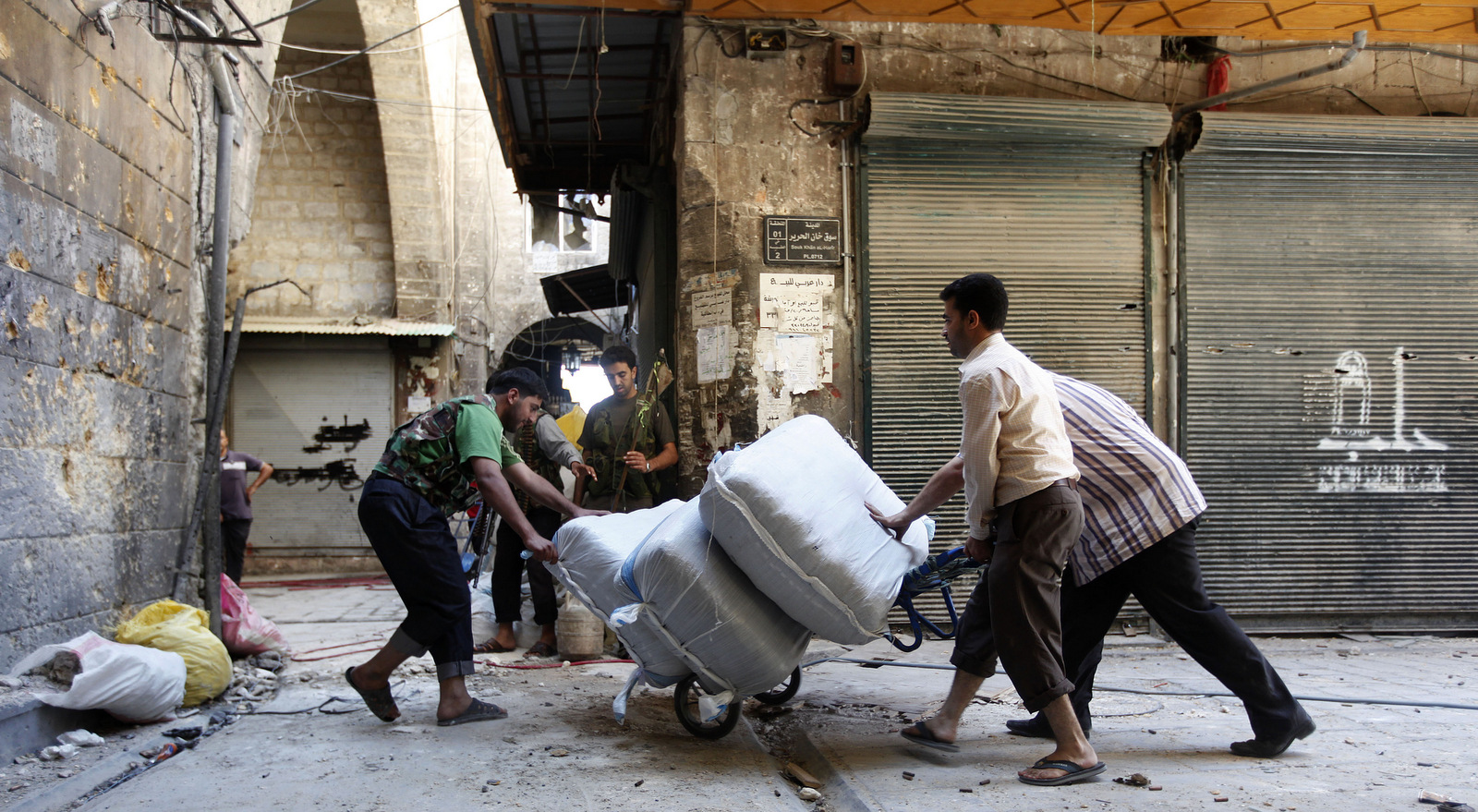
A Free Syrian Army fighter moves supplies at the souk of the old city of Aleppo city, Syria, September 24, 2012. The Arabic on the closed shop at right reads: “Aleppo.” (AP/Hussein Malla)
One cannot forget the images and eyewitness reports that emerged after the terrorist factions were finally driven from East Aleppo. Whole warehouses full of foods and medical supplies, from foreign donors — which were never allowed to be utilized by the suffering civilians — were discovered. While CNN and BBC broadcast tear-jerking reports of the “last” medicine in Aleppo, there was, in fact, plenty in storage, but the rebel groups refused to allow needy civilians to use it. This is a classic example of the terrorists’ practice of hoarding supplies for their own consumption, or to be sold for cash to other groups.
Terrorist factions have a motive for keeping the civilians starving: it keeps them docile and easy to manipulate. If they were treated well, they might have enough strength to fight or escape. Docile and suffering civilians are a resource to terrorists: for cooking chores, cleaning chores, manual labor, digging tunnels, and sexual abuse.
The shelling of Bab Touma

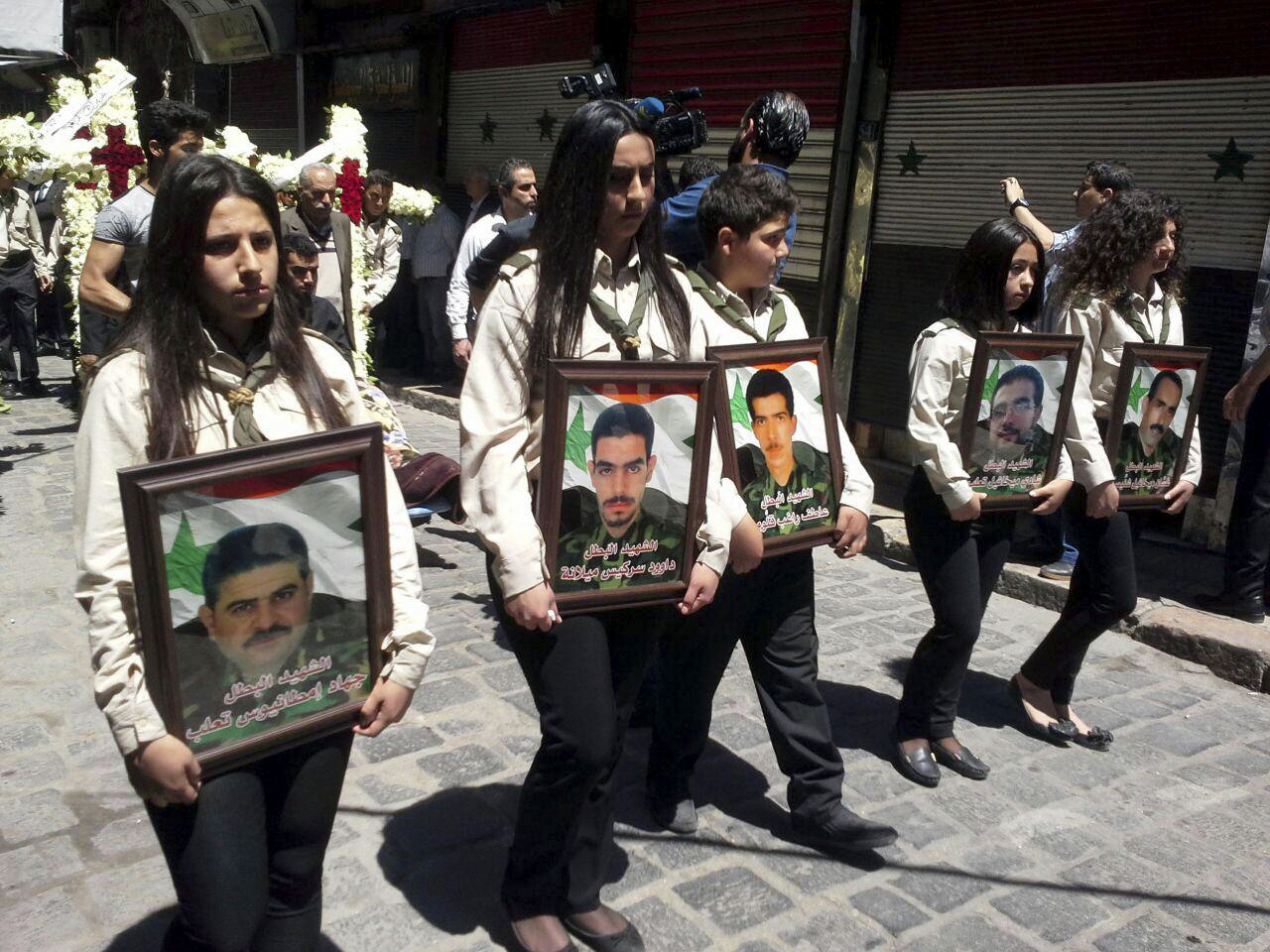
Girls carry the pictures of five Syrian Christian men who were kidnapped four years ago by rebel groups during their funeral prayers in Bab Touma, a predominantly Christian quarter of the Syrian capital Damascus, Syria, April 25, 2017. (SANA via AP)
Bab Touma is a Christian neighborhood, full of homes, churches, restaurants and hotels. It is historic, and also touristic. When Syria was a safe travel destination, Bab Touma is where many Western tourists stayed. It is on the Eastern edge of the “Old City” complex in Damascus and lies to the West of Jobar.
Rebel groups routinely, almost daily, shell Bab Touma with mortars and rockets, and because their weapons are safely tucked away in an elaborate underground stockpile, the supply is almost never-ending.
The Syrian conflict is in the final stages of the ground war. Analysts predict the Syrian Arab Army, along with its allies, will dislodge the terrorists in Jobar, and clear out all the tunnels. Once rebel factions lose Jobar, they can never regain it. Damascus will be secure.
The final battle in Syria will be in Idlib, to the North. It looks like a daunting task but, — given the fact of so much allied military support, from Turkey as well as Syria’s allies Russia, Iran, and Hezbollah — the numbers weigh in favor of the Syrian side. The various foreign supporters of the terrorist groups in Syria appear to have bet on the wrong horse.
On the political side: the U.N. and Russia have insisted that the Syrian people will be the ones to decide their future leadership at the election box. Regardless of the American, NATO and Arab Gulf demand for an immediate change in leadership in Damascus, without the benefit of democratic elections, it appears the battlefield victories of the Syrian government will ensure that it is the Syrian voter who has the last word.
Top photo | A Syrian army soldier walks on a street in the Jobar neighborhood of Damascus, Syria, August 24, 2013. (AP Photo)
<!–
–>
Source Article from http://www.mintpressnews.com/the-last-days-of-jobar-mark-the-end-of-the-proxy-war-in-syria/235453/
 RSS Feed
RSS Feed















 December 13th, 2017
December 13th, 2017  Awake Goy
Awake Goy 
 Posted in
Posted in  Tags:
Tags: 













